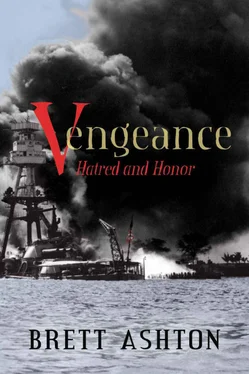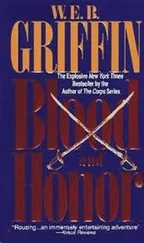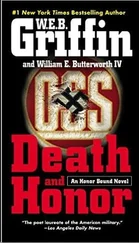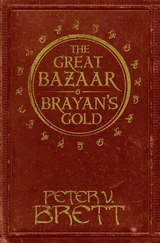Chuck was in the middle of telling me about some of the improvements in the optics on the directors for the secondary batteries when I noticed one of the watches on the starboard side sit up and grab his binoculars. It is interesting how you get “in tune” with the crew and recognize exactly when one of them notices something wrong.
I held up my hand to signal Lewis to stop talking and looked off in the direction the watch was looking, and with my other hand, reached for my own binoculars. For several seconds, I scanned the water between the horizon and the starboard bow.
The escorting destroyers were pretty far out, so the sound of the Buffalo going through the water didn’t mess with their sonar. The water was perfectly smooth except for a series of tiny ripples, almost undetectable by the human eye, maybe several hundred yards out, and proceeding at a rapid pace directly across the course of my ship.
“Damn!” I said to Lewis, just as the watch turned around and shouted, “ Torpedoes starboard bow! Range six hundred yards!”
“Battle stations now! ” I responded as I began the mental calculations on exactly how to defend my ship for the attack that had just begun.
We weren’t totally unprepared, but we weren’t exactly expecting an attack on a day like this, either, which is probably exactly what the captain of the Japanese sub was thinking, and why he decided to attack. In some ways, it was just like Pearl. It was a surprise attack.
“Sneaky Jap bastards are good at that,” I thought.
It still amazes me how fast the human mind, even when caught by surprise, can look at a set of variables and come up with the best possible solution for the situation. I could see four distinctly different wakes coming toward us, fanned out over several degrees from the firing point, and right away, I could tell the captain of the Jap sub that fired them was a good shot. His turn in the game was well played, and now, what should I do about it?
If the Buffalo would accelerate quickly enough on a straight course, we could have one pass aft, but we would still be hit by at least two, probably three. If we maintained current course and speed, we would have one pass forward and still be hit by three. If we could turn quickly enough, with enough acceleration, maybe we could have one pass forward and one aft, but still be most likely hit by two, and if extremely lucky, maybe one or even none. A turn to port would leave the ship’s propellers toward the torpedoes, resulting in the possible loss of propulsion. A starboard turn would protect the propellers but would sacrifice some ship’s stores and forward battery powder magazines.
However, if a torpedo hits the engineering spaces in a turn either direction, particularly below the armor belt, propulsion could still be lost. And a hard starboard turn causes the ship to roll to port, leaving the armor protection well above the normal level in the water. A port turn would push the ship’s armor deeper into the water on the starboard side and minimize the damage done to the internal systems. It all depended on how fast the Buffalo could accelerate and how quickly she could turn.
On top of all of that, the crew wouldn’t reach their battle stations until well after the torpedoes hit. A good portion of the watertight doors and hatches would not be closed, so there would be a lot of additional flooding to deal with.
All of these thoughts, and more, flooded my mind as I worked out the different scenarios. In the blink of an eye, my mind turned out a hundred different pictures of what could happen next. The lives of all on board depended on getting the best possible answer, and maybe even that wouldn’t be good enough. And in another blink of an eye, I selected the one on which all of our hopes and prayers would shortly come to rest.
“ Hard to starboard, emergency flank speed! Now, goddamn it! ” I shouted to the helmsman, who no doubt was prepared for my orders and began spinning the wheel in his hands as quickly as I spoke. And slowly, too slowly for comfort, the twelve-thousand tons of steel named Buffalo began to accelerate and turn to face the oncoming torpedoes.
As the seconds passed, the ship began its predicted roll toward the port side, thus raising the starboard armor belt high up out of the water. I stared unblinking at the oncoming torpedo wakes as they sped toward the unprotected underbelly of the Buffalo . Timing was everything, and this had to be timed just right, or the best possible outcome could quickly become the worst.
I turned my attention to the closest of the torpedoes, the forward one. It began to look like it would miss by a long shot, evaded by the quickness of the Buffalo ’s starboard turn. I looked at the aft one and knew it would be close but would most likely miss. The ship, as I predicted, would not be agile enough to avoid all of the torpedoes. By then, the other two were getting very close, so I decided it was time to put the armor belts back into the water to protect the ship, as they may, from the inevitable explosions. No way around it; some of us were going to die.
“ Hard to port! ” I shouted at the helm. And, much more quickly, the Buffalo responded, having accelerated to attack speed. The ship rapidly began a starboard roll, shoving the armor belt deep down into the water.
I quickly checked my forty-five as I watched the oncoming torpedoes.
Several twenty-millimeter guns opened fire in a last-ditch attempt to detonate the torpedoes before they contacted the ship. Sometimes, if you are lucky, it works, but most of the time it doesn’t.
The forward one sped by some distance from the ship. The second one was going to hit the bow section of the Buffalo ; it was inevitable. The third was going to hit amidships. The fourth was going to be close, maybe feet or inches between hit or miss; it was hard to tell. All I could do to protect the ship had been done at that point, so I ducked and waited the last few seconds for the explosions, resigning the Buffalo and her crew to their fate.
Boom! The first torpedo hit forward, sending a plume of water and small debris high above the ship that showered down over all of the forward weather decks. The Buffalo convulsed violently as the smell of the chemicals in the explosives mixed with fuel oil filled the air.
Boom! The second torpedo hit amidships, and once again, the Buffalo , in the thrashing violence of agony, tried to leap out of the water. “That’s the one that is going to hurt,” I thought to myself as more oily salt water showered down over the bridge.
I got up and looked aft, deciding to look at the fourth torpedo wake to see if it would miss. The forward smokestack began to belch out steam, which was usually symptomatic of a boiler in the fire room flooding, which blocked my view of the aft parts of the ship. I couldn’t follow the track of the torpedo all the way, but it looked like it had passed very near the ship and, thank God, missed.
Now, I have to say that any torpedo is more powerful than you would want to be around when it goes off, but these ones seemed milder than the one that struck the North Carolina earlier in the war. I thought at the time maybe the Japanese were using up stocks of older, less powerful torpedoes than they had been using earlier on. The Japanese supply lines had been disrupted very badly at that time, and maybe they had been having troubles building newer models and were forced to use older prewar versions. After the Japanese surrendered, it was discovered from their records this was exactly what had occurred. And that fact alone may have saved the Buffalo .
The next thing in the order of combat I had to do was to try and present as small of a target to the enemy as possible while at the same time, widening the distance. “Continue port turn to heading one zero five,” I told the helm. This would leave our propellers toward them but would widen the distance and lower our profile to them, leaving less of a target.
Читать дальше












